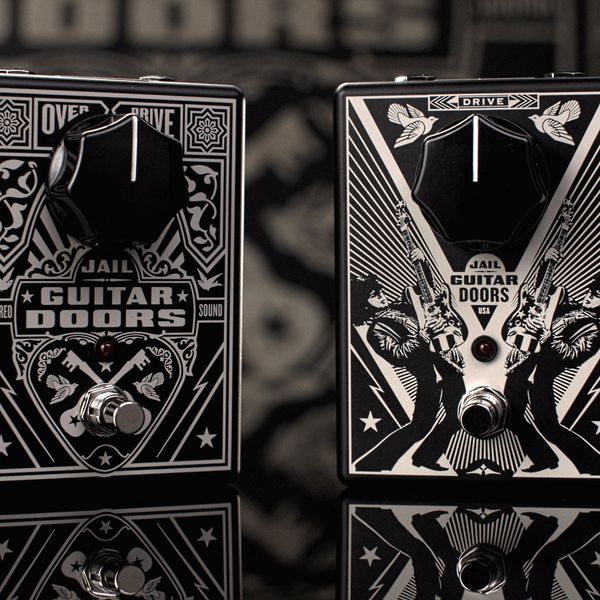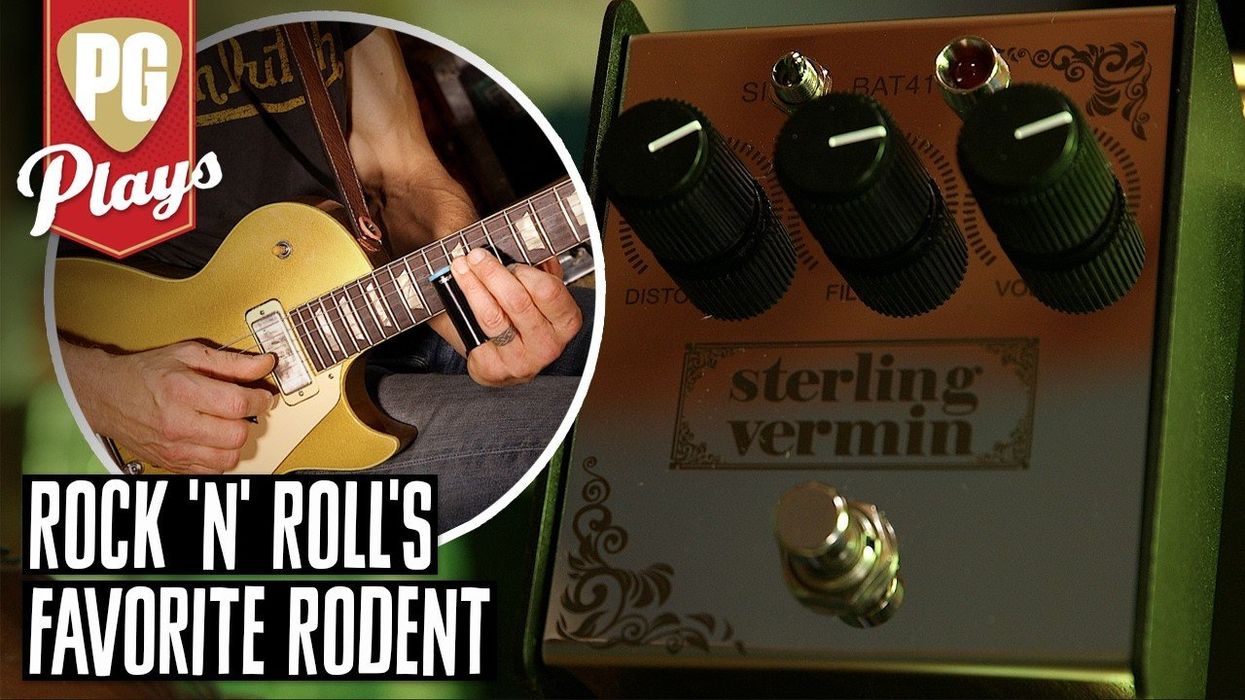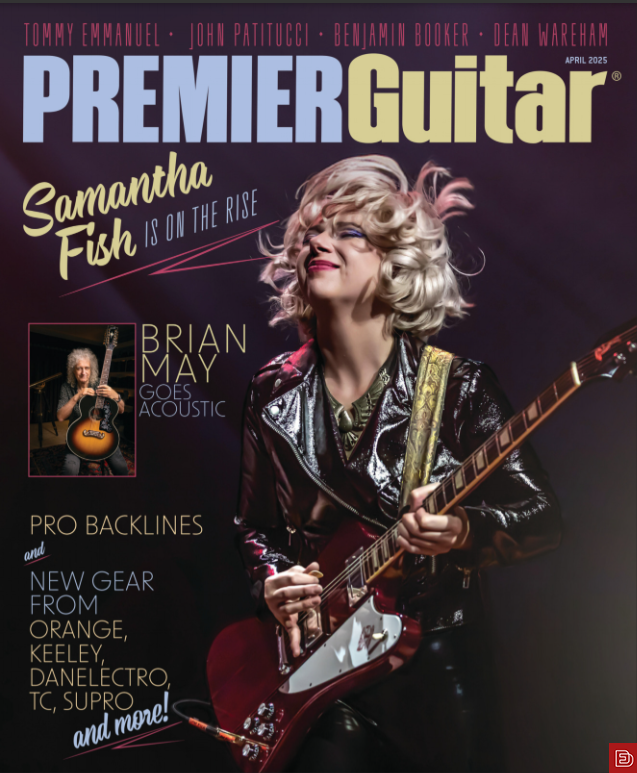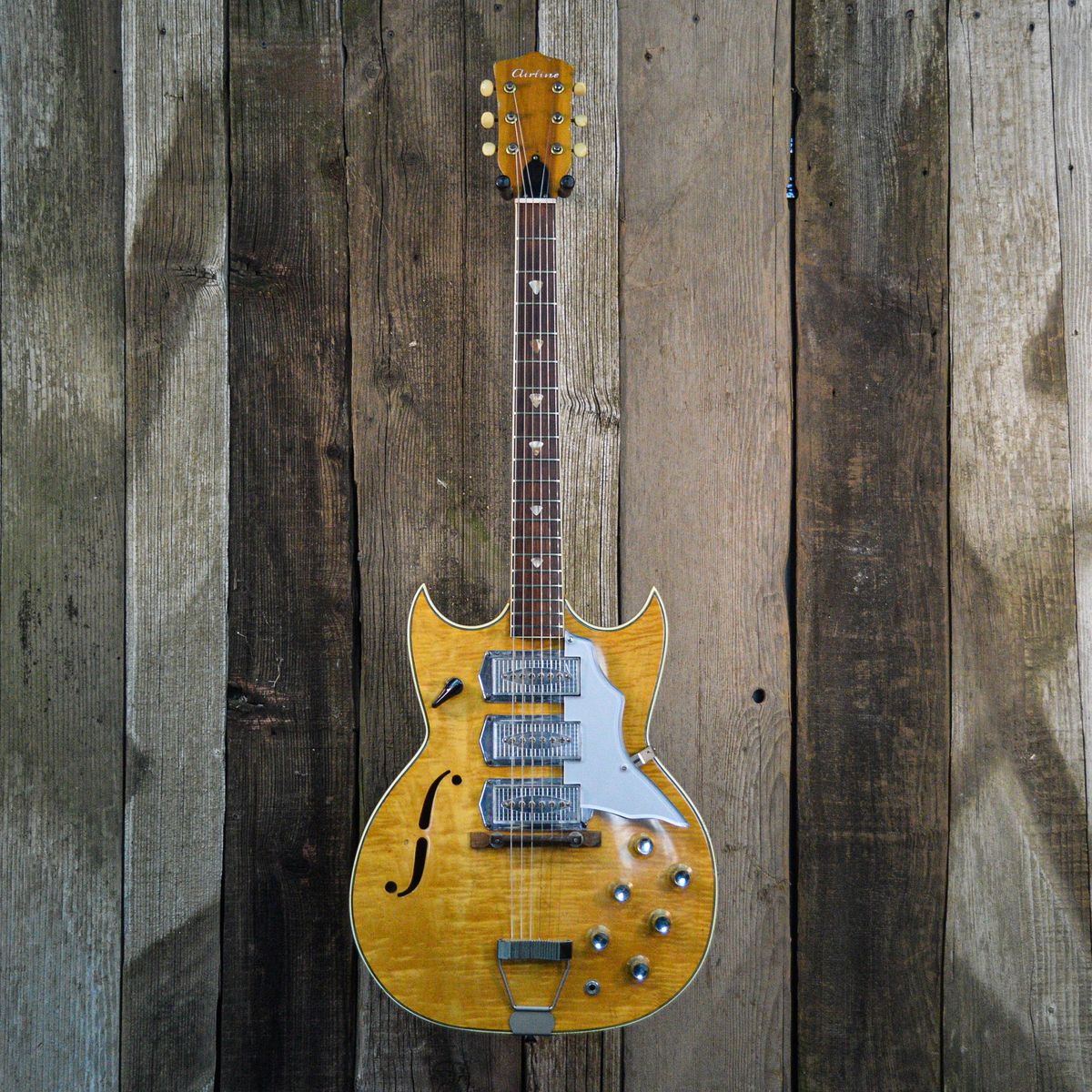
Although it's not a Kessel or Gold K series instrument, this Airline/Kay Swingmaster P-5 is a gorgeous hollowbody with appointments that revisit those earlier premium models.
The Kay-made Swingmaster P-5 carries the torch for its higher-end predecessors, like the company's Barney Kessel model.
When the guitar boom of the 1960s hit, manufacturing operations all over the world rushed to meet skyrocketing demand. There were factories in Japan and Italy, in Southern California and Czechoslovakia, and, perhaps most prolifically of all, in Chicago, Illinois—that long-established center of American retail distribution. Chicago instrument makers churned out entry-level guitars in enormous volumes, and by the time of Beatlemania, it seemed like they couldn't build them fast enough.
The three big names from this time and place were Harmony, Valco, and, the maker of today's featured instrument, Kay. All three companies competed and at times collaborated, and supplied instruments to retailers like Sears and Montgomery Ward to be sold under a dizzying array of brand names.
This is one of a series of Kay-made instruments with appointments similar to that of the earlier Gold K generation.
In today's vintage market, Harmony is known for the sheer volume of beginner guitars it produced, while Valco, the company behind brands like Supro and National, has enjoyed something of a Jack White-ified resurgence over the past two decades. (Believe it or not, "Fell in Love with a Girl" was released in 2001.) Kay's reputation and legacy, while high among a certain set of collectors and players, is perhaps less well defined, but still claims a fascinating history of its own.
Like Harmony, Kay's origins can be traced to the 1890s when it started as the Groeschel Mandolin Company. In the 1920s and '30s, it went through some name changes, eventually landing on Kay Musical Instrument Company under the leadership of Henry Kuhrmeyer. Kay was right there at the birth of the electric guitar as one of the first makers to explore this new arena in the 1930s.
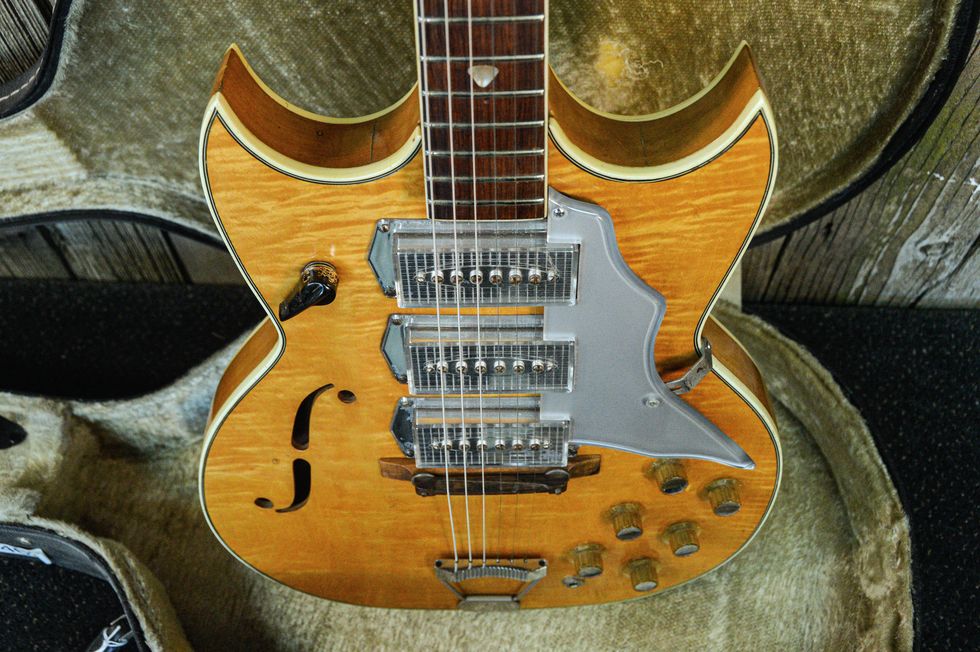
These Kleenex box variations on the P-90 have larger pole pieces, but typically less midrange than actual P-90s, giving them a distinctive tone that's highly sculptable thanks to individual pickup tone and volume controls.
The most intriguing stretch of Kay's history came in the late 1950s, when it sought to compete directly with higher-end brands and market more professionally oriented guitars, called the Gold K series, which included a set of signature models for jazz great Barney Kessel. A Kay catalog from 1959 proclaims, "Only Kay offers you so complete a line—ranging from a $24.50 student model to a $400 professional electric." A $400 guitar in this era would put it on the same shelf as a high-end Gibson. Mr. Kessel himself made the switch to Gibson by 1961, which, going by the guitars featured in Kay catalogs from this period, coincides with a refocus by the company towards the lower end of the market.
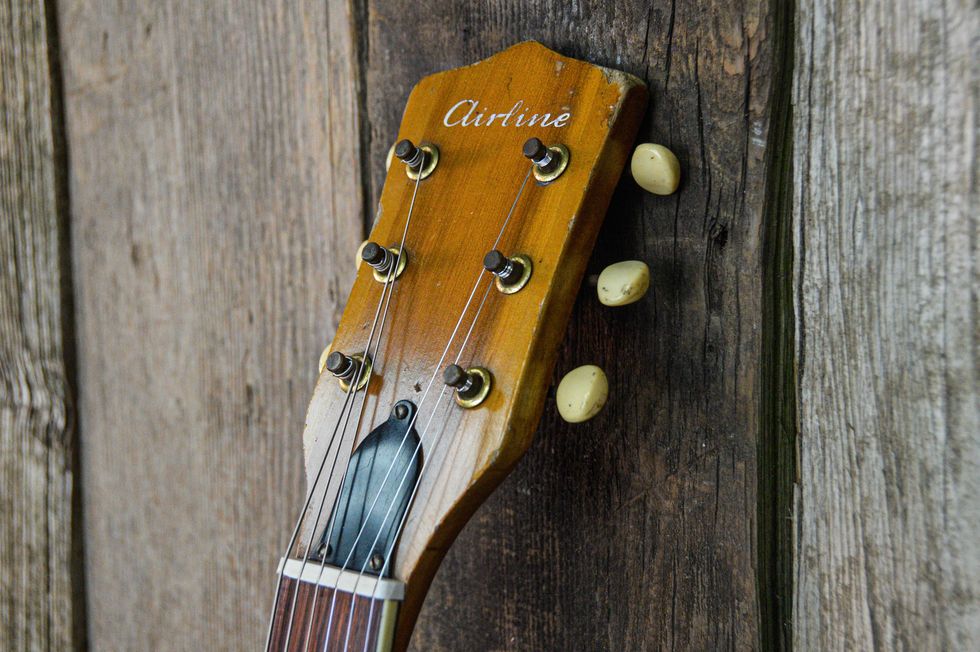
The humble headstock marks this Kay-built Airline as a more affordable model than its Kelvinator-headstock-equipped inspirations. Nonetheless, it is a formidable example from the heyday of Chicago guitar builders.
The Gold K and Kessel models (along with the Thin Twin, which was played by bluesman Jimmy Reed) are the most recognizable vintage Kays and are set apart by their higher-end hardware—flourishes like the ornate "Kelvinator" headstock (which, along with the pickup frames and pickguard, resembled the appointments of that company's line of appliances) and the distinct Gold K pickups, sometimes called Kleenex box pickups, for obvious reasons. Moving through the '60s, as Kay shifted away from the original Gold K guitars, these pickups—a variation on the P-90, with larger pole pieces—continued to be used on other models including today's featured instrument, the hollowbody Swingmaster P-5 archtop. Sold under the Airline brand name exclusively through Montgomery Ward, this guitar shows up in a 1965 edition of their catalog simply as an Archtop Dual Cutaway. While often vintage dealers and others label any Kay with the Kleenex box pickups a Barney Kessel model, this does not appear to have been the actual designation. Instead, this is one of a series of Kay-made instruments with appointments similar to that of the earlier Gold K generation, but overall, more in the mold of the other guitars then being sold through catalog partners.
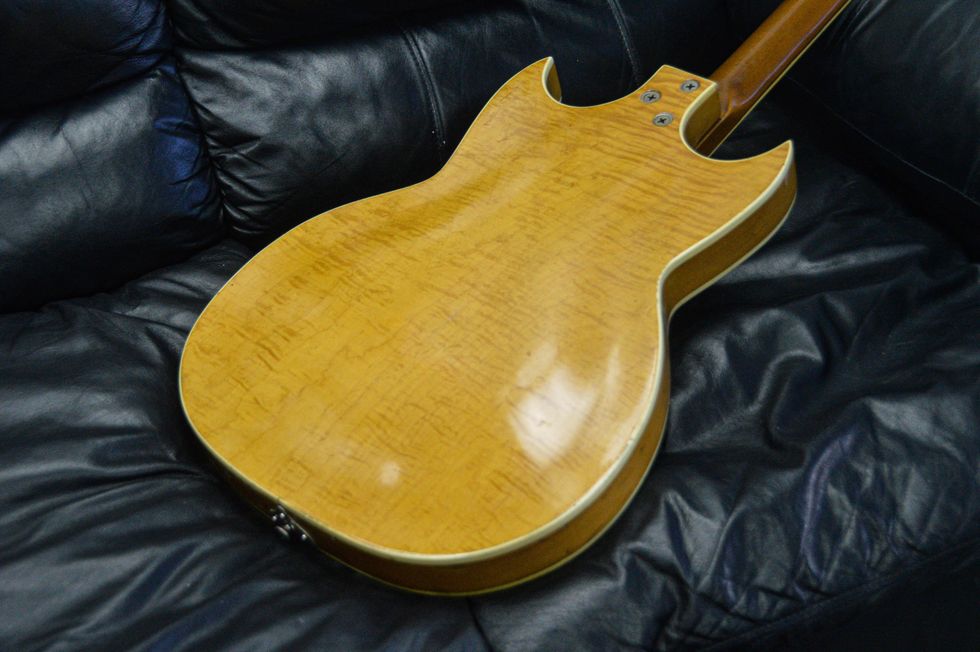
Here's an unobstructed view of the curly maple back of this Airline Swingmaster P-5. The neck appears to be rosewood.
According to the Reverb listing for this guitar from Guitar Showcase of San Jose, California, it has a replacement bridge and some swapped screws, as well as a noticeable crack on the bottom near the trapeze tailpiece hinge. The listing also points out the strength of the Kleenex box pickups, which are controlled by a 3-way selector and individual tone and volume dials. The triple set of pickups on this guitar is part of what makes this model one of the most sought-after Kay instruments of the 1960s—at about one-third to one-half the price of a two-pickup Kay with the actual Kessel designation and Kelvinator headstock. This specific guitar was listed at $1,995.
There's a tendency for those of us who are interested in the history of gear to seek easy categorization and neat, orderly model names and serial number sequences. During the '60s guitar boom, among the wholesaling factories things were never quite so simple. They used what parts they had. That stack of bodies might meet that pile of necks, and the result might contrast a bit with how that model looked last year or will look in the next batch. Oddities, contradictions, and inconsistent information abound on the vintage market when it comes to Chicago guitars, and Airline-branded Kays like this one are a typical example. Ultimately, though, it's this mysteriousness and the possibility of finding something truly unique that makes guitars like this so much fun.
- Vintage Vault: 1968 Gibson Trini Lopez Deluxe - Premier Guitar ›
- Vintage Vault: Late-'70s Mesa/Boogie Mark I and Mark II Combos ... ›
- Vintage Vault: 1960s Kay Swingmaster K763 - Premier Guitar ›
-
Crank the heat! PG's John Bohlinger plugs into the boutique-built Sterling Vermin, a modern twist on the iconic Rat distortion. Hear it rip through Strats, Teles, and a Les Paul with classic snarl and smooth silicon/BAT41 clipping.
Sterling Vermin RAT
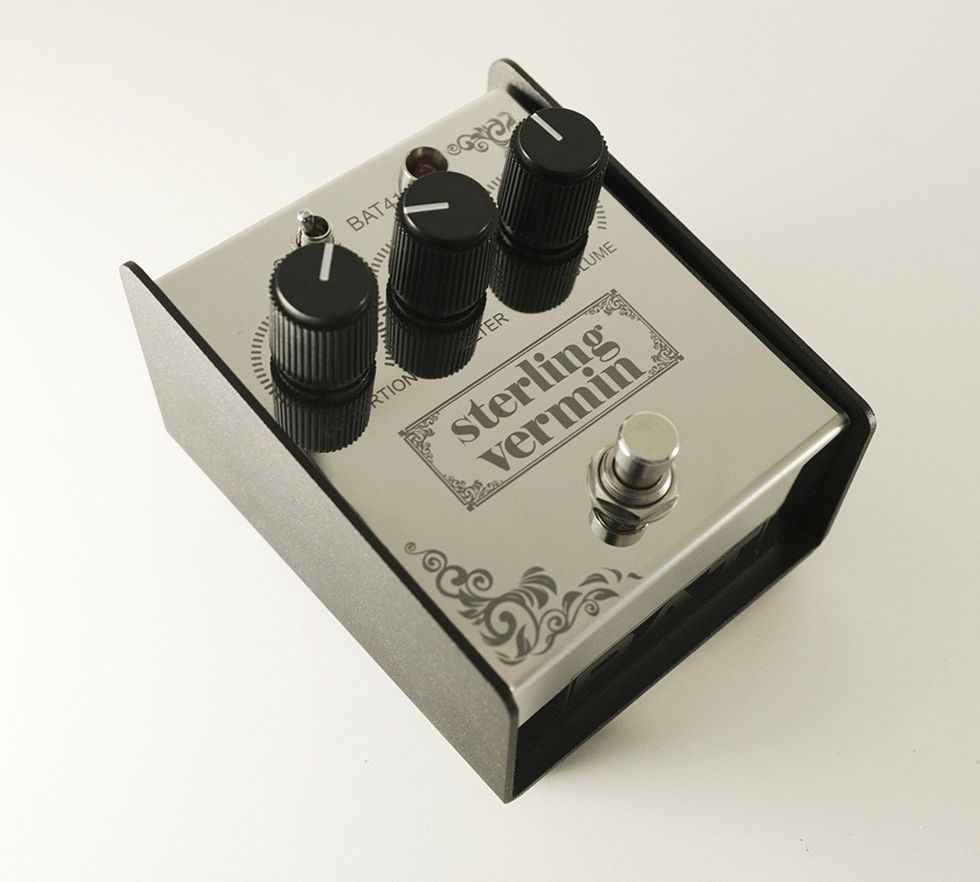
The Sterling Vermin was born from a desire for something different — something refined, with the soul of a traditional RAT pedal, but with a voice all its own.
Built in small batches and hand-soldered in ACT’s Jackson, Missouri headquarters, the Sterling Vermin is a work of pure beauty that honors the brand legacy while taking a bold step forward for creativity.
The Sterling Vermin features the LM741 Op-Amp and a pair of selectable clipping diodes. Players can toggle between the traditional RAT silicon diode configuration for a punchy, mid-range bite, or the BAT41 option for a smoother, more balanced response. The result is a pedal that’s equally at home delivering snarling distortion or articulate, low-gain overdrive, with a wide, usable tonal range throughout the entire gain spectrum.
The pedal also features CTS pots and oversized knobs for even, responsive control that affords a satisfying smoothness to the rotation, with just the right amount of tension. Additionally, the polished stainless-steel enclosure with laser-annealed graphics showcases the merging of the pedal’s vintage flavor and striking design.
From low-gain tones reminiscent of a Klon or Bluesbreaker, to high-gain settings that flirt with Big Muff territory — yet stay tight and controlled — the Sterling Vermin is a masterclass in dynamic distortion. With premium components, deliberate design and a focus on feel, the Sterling Vermin is more than a pedal, it’s a new chapter for RAT.
The veteran Florida-born metalcore outfit proves that you don’t need humbuckers to pull off high gain.
Last August, metalcore giants Poison the Well gave the world a gift: They announced they were working on their first studio album in 15 years. They unleashed the first taste, single “Trembling Level,” back in January, and set off on a spring North American tour during which they played their debut record, The Opposite of December… A Season of Separation, in full every night.
PG’s Perry Bean caught up with guitarists Ryan Primack and Vadim Taver, and bassist Noah Harmon, ahead of the band’s show at Nashville’s Brooklyn Bowl for this new Rig Rundown.
Brought to you by D’Addario.Not-So-Quiet As a Mouse
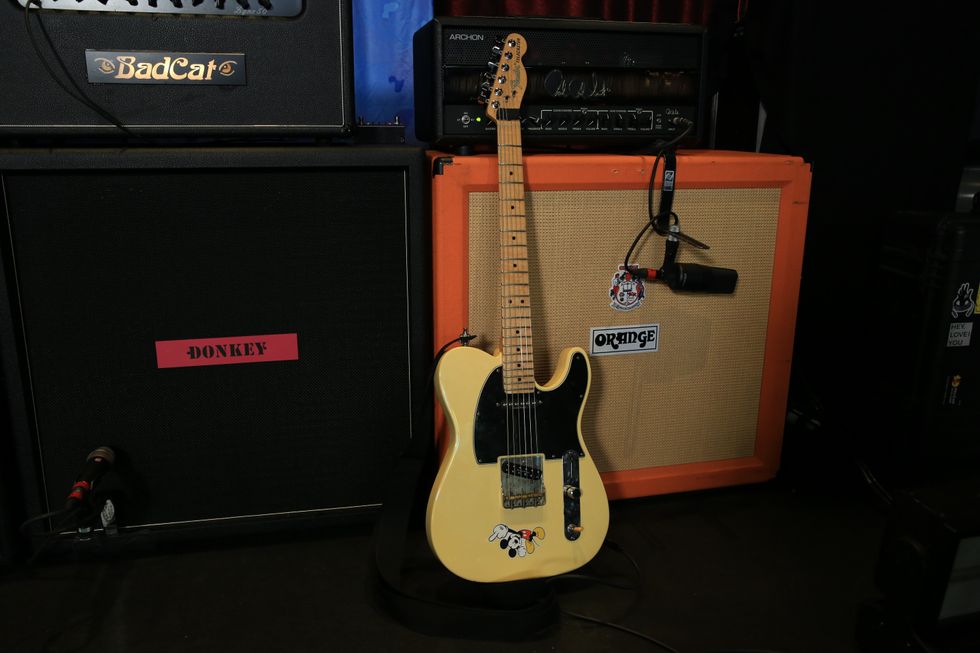
Primack started his playing career on Telecasters, then switched to Les Pauls, but when his prized LPs were stolen, he jumped back to Teles, and now owns nine of them.
His No. 1 is this white one (left). Seymour Duncan made him a JB Model pickup in a single-coil size for the bridge position, while the neck is a Seymour Duncan Quarter Pound Staggered. He ripped out all the electronics, added a Gibson-style toggle switch, flipped the control plate orientation thanks to an obsession with Danny Gatton, and included just one steel knob to control tone. Primack also installed string trees with foam to control extra noise.
This one has Ernie Ball Papa Het’s Hardwired strings, .011–.050.
Here, Kitty, Kitty
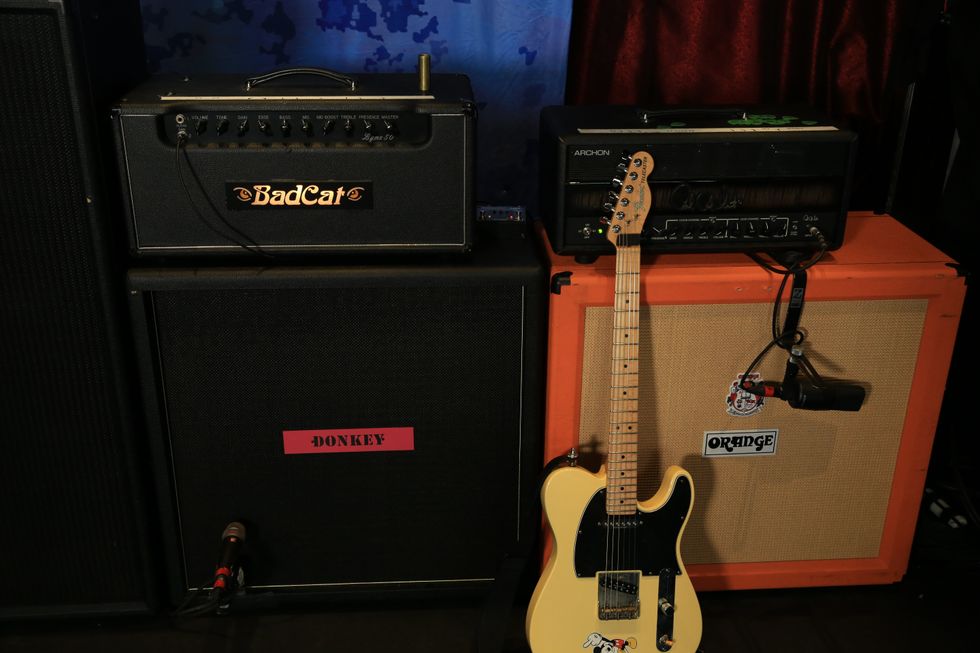
Primack runs both a PRS Archon and a Bad Cat Lynx at the same time, covering both 6L6 and EL34 territories. The Lynx goes into a Friedman 4x12 cab that’s been rebadged in honor of its nickname, “Donkey,” while the Archon, which is like a “refined 5150,” runs through an Orange 4x12.
Ryan Primack’s Pedalboard
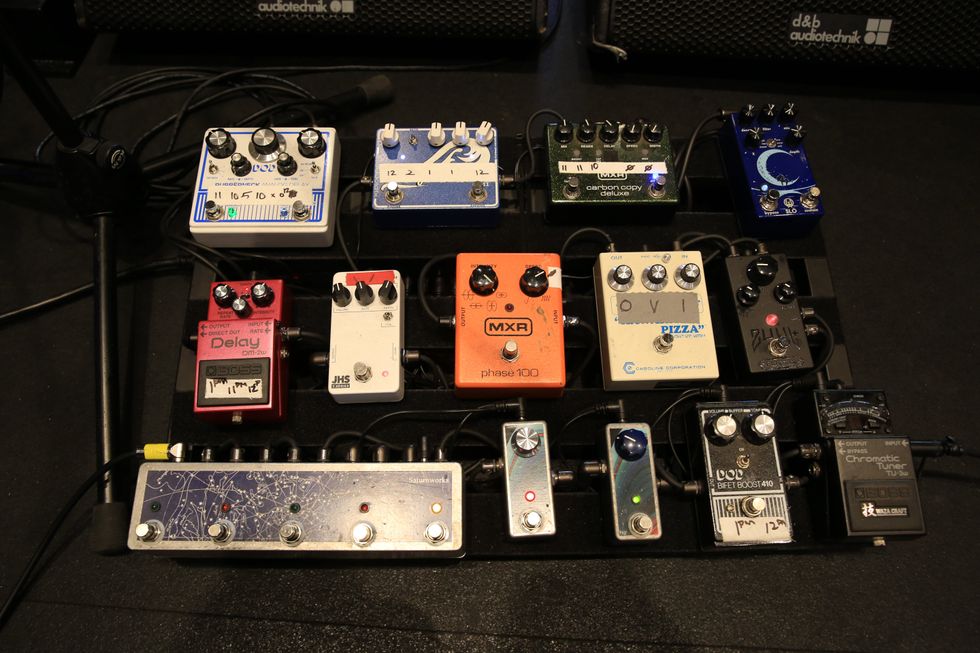
Primack’s board sports a Saturnworks True Bypass Multi Looper, plus two Saturnworks boost pedals. The rest includes a Boss TU-3w, DOD Bifet Boost 410, Caroline Electronics Hawaiian Pizza, Fortin ZUUL +, MXR Phase 100, JHS Series 3 Tremolo, Boss DM-2w, DOD Rubberneck, MXR Carbon Copy Deluxe, Walrus Slo, and SolidGoldFX Surf Rider III.
Taver’s Teles
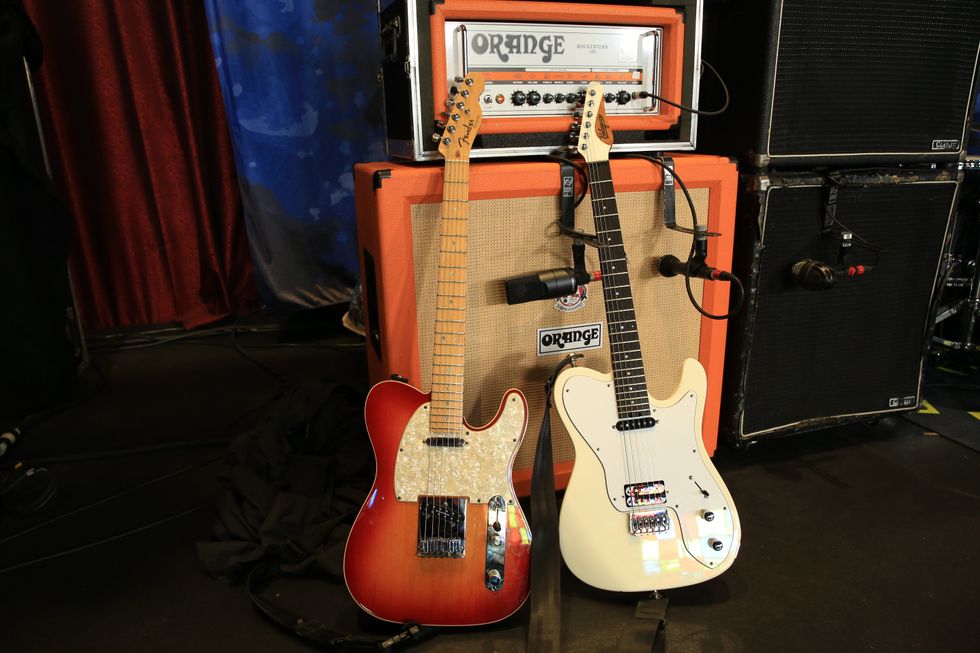
Vadim Taver’s go-to is this cherryburst Fender Telecaster, which he scored in the early 2000s and has been upgraded to Seymour Duncan pickups on Primack’s recommendation. His white Balaguer T-style has been treated to the same upgrade. The Balaguer is tuned to drop C, and the Fender stays in D standard. Both have D’Addario strings, with a slightly heavier gauge on the Balaguer.
Dual-Channel Chugger
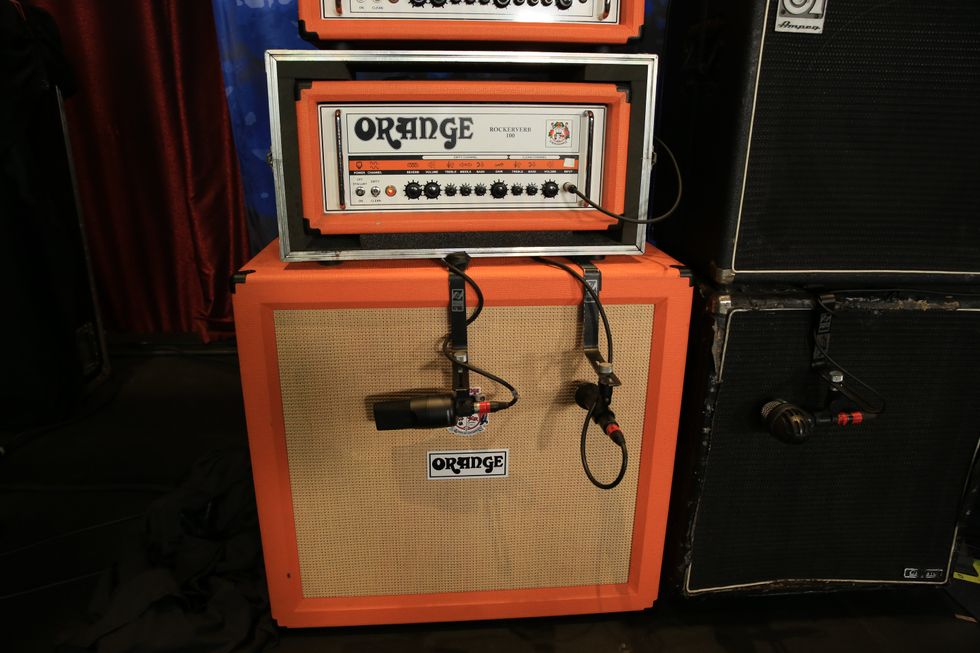
Taver loves his 2-channel Orange Rockerverb 100s, one of which lives in a case made right in Nashville.
Vadim Taver’s Pedalboard
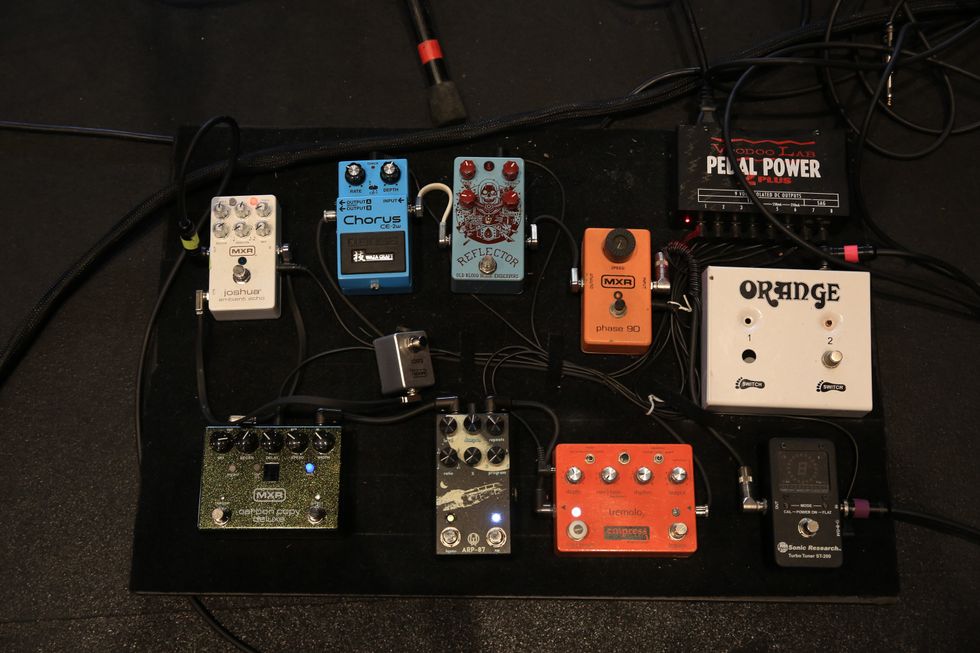
Taver’s board includes an MXR Joshua, MXR Carbon Copy Deluxe, Empress Tremolo, Walrus ARP-87, Old Blood Noise Endeavors Reflector, MXR Phase 90, Boss CE-2w, and Sonic Research Turbo Tuner ST-200, all powered by a Voodoo Lab Pedal Power 2 Plus.
Big Duff
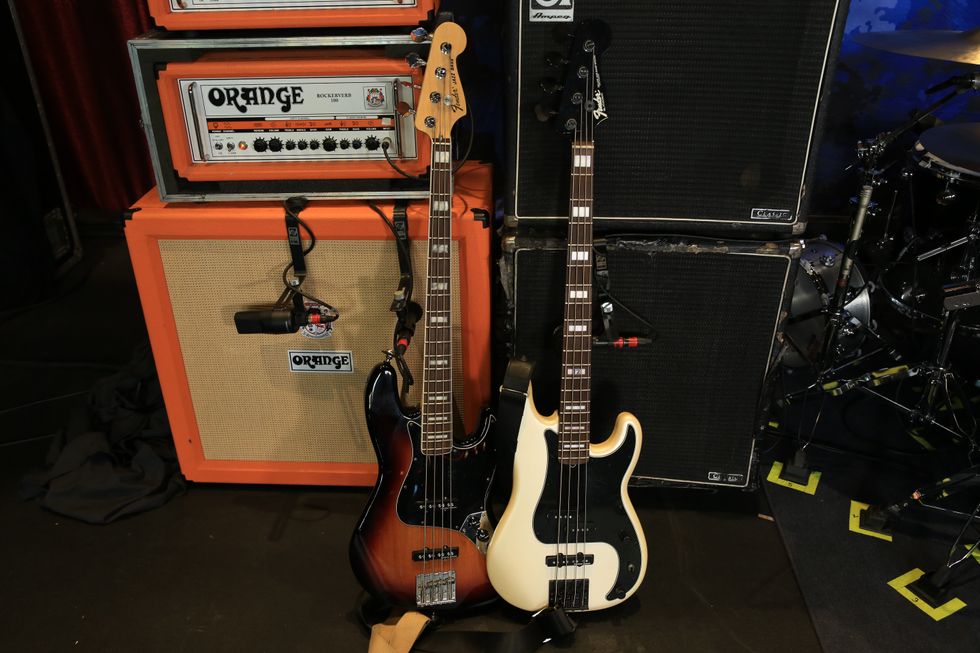
Harmon’s favorite these days is this Fender Duff McKagan Deluxe Precision Bass, which he’s outfitted with a Leo Quan Badass bridge. His backup is a Mexico-made Fender Classic Series ’70s Jazz Bass. This one also sports Primack-picked pickups.
Rental Rockers
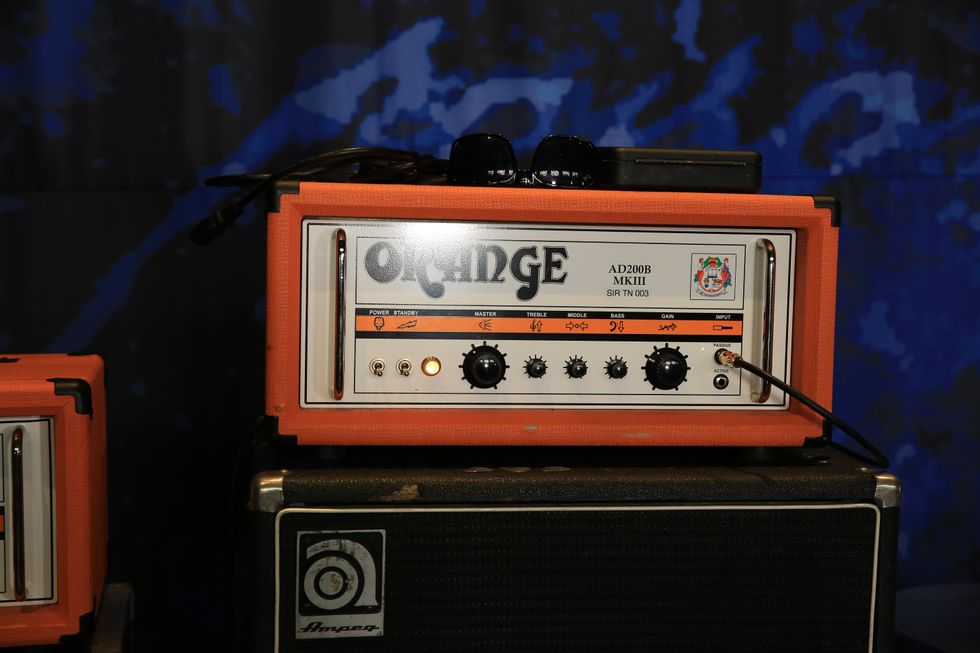
Harmon rented this Orange AD200B MK III head, which runs through a 1x15 cab on top and a 4x10 on the bottom.
Noah Harmon’s Pedalboard
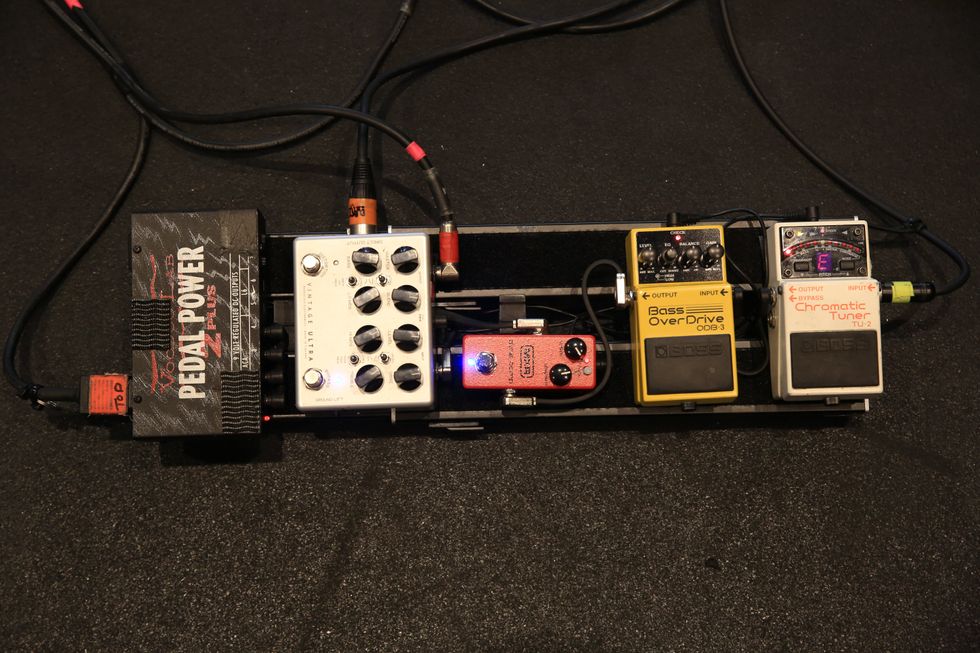
Harmon’s board carries a Boss TU-2, Boss ODB-3, MXR Dyna Comp, Darkglass Electronics Vintage Ultra, and a Voodoo Lab Pedal Power 2 Plus. His signal from the Vintage Ultra runs right to the front-of-house, and Harmon estimates that that signal accounts for about half of what people hear on any given night.

Kiesel Guitars has introduced their newest solid body electric guitar: the Kyber.
With its modern performance specs and competitive pricing, the Kyber is Kiesel's most forward-thinking design yet, engineered for comfort, quick playing, and precision with every note.
Introducing the Kiesel Kyber Guitar
- Engineered with a lightweight body to reduce fatigue during long performances without sacrificing tone. Six-string Kybers, configured with the standard woods and a fixed bridge, weigh in at 6 pounds or under on average
- Unique shape made for ergonomic comfort in any playing position and enhanced classical position
- The Kyber features Kiesel's most extreme arm contour and a uniquely shaped body that enhances classical position support while still excelling in standard position.
- The new minimalist yet aggressive headstock pairs perfectly with the body's sleek lines, giving the Kyber a balanced, modern silhouette.
- Hidden strap buttons mounted on rear for excellent balance while giving a clean, ultra-modern look to the front
- Lower horn cutaway design for maximum access to the upper frets
- Sculpted neck heel for seamless playing
- Available in 6 or 7 strings, fixed or tremolo in both standard and multiscale configurations Choose between fixed bridges, tremolos, or multiscale configurations for your perfect setup.
Pricing for the Kyber starts at $1599 and will vary depending on options and features. Learn more about Kiesel’s new Kyber model at kieselguitars.com
The Sunset is a fully analog, zero latency bass amplifier simulator. It features a ¼” input, XLR and ¼” outputs, gain and volume controls and extensive equalization. It’s intended to replace your bass amp both live and in the studio.
If you need a full sounding amp simulator with a lot of EQ, the Sunset is for you. It features a five band equalizer with Treble, Bass, Parametric Midrange (with frequency and level controls), Resonance (for ultra lows), and Presence (for ultra highs). All are carefully tuned for bass guitar. But don’t let that hold you back if you’re a keyboard player. Pianos and synthesizers sound great with the Sunset!
The Sunset includes Gain and master Volume controls which allow you to add compression and classic tube amp growl. It has both ¼” phone and balanced XLR outputs - which lets you use it as a high quality active direct box. Finally, the Sunset features zero latency all analog circuitry – important for the instrument most responsible for the band’s groove.
Introducing the Sunset Bass Amp Simulator
- Zero Latency bass amp simulator.
- Go direct into the PA or DAW.
- Five Band EQ:
- Treble and Bass controls.
- Parametric midrange with level and frequency controls.
- Presence control for extreme highs.
- Resonance control for extreme lows.
- Gain control to add compression and harmonics.
- Master Volume.
- XLR and 1/4" outputs.
- Full bypass.
- 9VDC, 200mA.
Artwork by Aaron Cheney
MAP price: $210 USD ($299 CAD).


